Final Project, SPRING 2008
These beautiful true-color images were taken and processed by the students named above the images.
The text below the images was taken from the students' reports.
Click on the images to see the full size versions.
Miles Hoffman |
Jonathan Khan |
Ryan MacIntire |
Stephanie Milczarski |
Caroline Savio |
Jason Shedden |
David Sutton |
||||||||||||||||||||||||||||||||||||||||||||||||||||||||||||||||||||||||||
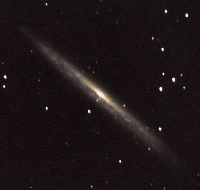 |
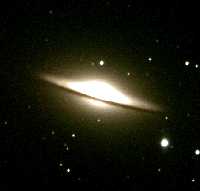 |
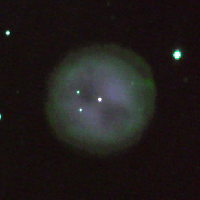 |
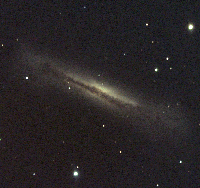 |
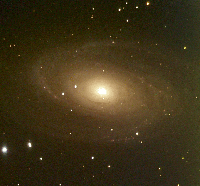 |
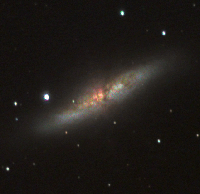 |
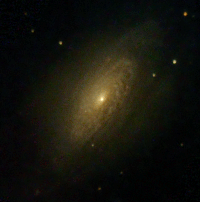 |
||||||||||||||||||||||||||||||||||||||||||||||||||||||||||||||||||||||||||
NGC 5907 is a Spiral galaxy that is located in the Draco constellation. It is approximately 39 million light years away from Earth. It is comprised of mostly dwarf stars and very few giant stars. William Herschell first discovered this galaxy on May 5 th 1788. The last major occurrence in this galaxy was a supernova which was recorded on February 16 th 1940. It reached a magnitude of 14.3.
|
Located between the constellations of Corvus and Virgo, this galaxy was discovered in 1767 by Pierre Méchain. M104 is an unbarred spiral galaxy, and in 1990, a supermassive black hole was discovered at its center. The distance to this magnitude 9.0 object is approximately 29 million light years. It can be seen with a good pair of binoculars, though an 8” or 10” telescope is needed to distinguish the disc shaped dust lane from the bulging center of this galaxy.
|
M97 is a planetary nebula which was discovered on February 16, 1781 by Pierre Méchain but was not given its name (The Owl Nebula) until 1848 when it was described as such by Lord Rosse . Lord Rosse named it The Owl Nebula due to its owl-eye like appearance as seen through a telescope greater than 200mm. This nebula is one of only four planetary nebulas in the catalog and is in the constellation Ursa Major. Magnitude: 11 Distance: 2.6 (kly) Dimensions: 3.4x3.3 (arc min)
|
The NGC 3628 spiral galaxy, along with the galaxies M65 and M66, make up the Leo Triplet in the Leo constellation. It is the faintest of the three, and thus was not found by Messier in 1780 when he discovered its neighbors. It was discovered four years later on April 8 by William Herschel. NGC 3628 is about 35 million light-years away and is seen edge-on. It is surrounded by a band of dark dust clouds that hide many of the stars in its spiral arms. The dust band is distorted in the outer regions of the galaxy because of the gravitational interaction with M65 and M66.
|
M81 is a spiral galaxy about 12 million light years away from the Earth and is located in the “handle” of the constellation Ursa Major (The “Big Dipper”). It is believed that the center harbors a super massive black hole. M81 was first discovered by Johann Elert Bode in 1774. In 1779, Pierre Méchain and Charles Messier re-identified Bode's object, which was then listed in the Messier Catalog.
|
The Cigar Galaxy was first discovered on December 31 st , 1774 together with M81 by a man named Johann Elert Bode. Pierre Mechain independently discovered both M81 and M82 in August 1779 and passed the information on to Charles Messier, who gave assigned them designation M81 and M82 in his catalog of deep sky objects. M82 sits in an area of the sky known as Ursa Major and is the galactic neighbor to M81. It is classified as an irregular galaxy due to its relatively recent (approximately 50 – 600 million years ago), gravitational interaction with M81, and is famous for the heavy star-forming activity as a result of that interaction. M82 is actually the brightest galaxy in the sky when viewed in the infrared, and is much brighter than when viewed in the visible light. It is also the strongest source of radio waves in the Ursa Major and is cataloged as 3C 231 in the Third Cambridge Catalog of Radio Sources. These are believed to be caused by the heavy star-forming activity as a result of the recent interaction with M81. The red seen at the central region of M82 is ionized gas driven out by the heavy star-formation. |
NGC3521 is a spiral galaxy located about 23 million light years away from us here on Earth. It is near the southern edge of the Leo constellation. With a magnitude of about 9.0 and an axis nearly 11 arc minutes, it can be seen even in smaller telescopes, if only as a faint light. It may be somewhat difficult to find, as there aren't any easy to find guide stars around it. It can be found a few degrees southwest of sigma Leo, which can be identified as the tip star of Leo's hind leg.
|